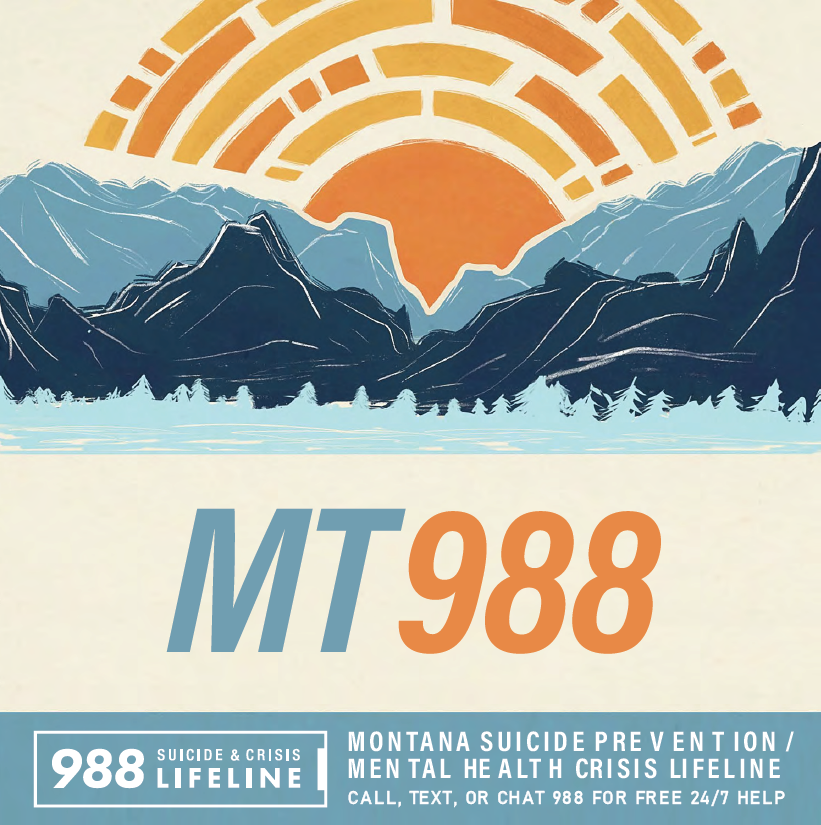Suicide Prevention Information and Resources
Depression is Treatable -- Suicide is Preventable
If you are in crisis and want help, please call, text, or chat the Montana Crisis Lifeline, 24/7, at 988.
Please feel free to download any of the following programs or resources.
If you have any questions or want additional information, please contact:
Karl Rosston, LCSW
Suicide Prevention Coordinator, Montana DPHHS
406-444-3349
krosston@mt.gov
- After Your Child’s Suicide Attempt
- A Guide for Taking Care of Your Family Member After Treatment in the Emergency Department
- A Guide for Taking Care of Yourself After Your Treatment in the Emergency Department
- A Guide for Medical Providers in the Emergency Department Taking Care of Suicide Attempt Survivors
- Handbook for Recovery After a Suicide Attempt
Locating Aging and Senior Services in Montana
Suicide and Older Adults: What You Should Know
Reducing Loneliness and Social Isolation among Older Adults
Increased Access to Mental Health Care for Older Adults
Promoting Psychological Health and Suicide Prevention among Older Adults
How the 988 Suicide and Crisis Lifeline can help with Aging Adults
Resources and Research in Preventing Suicide in Aging Adults
- Basic scoring guide for Clinicians
- PHQ - Questions
- SAFETY Plan Template
- Safety Planning Guide
- Safe-T Protocol with C-SSRS
- Suicide Prevention Toolkit for Rural Primary Care Providers
- Zero Suicide
- Assessment of Suicide Risk using C-SSRS (please watch training video before using scales)
- Handling a Suicidal Caller
- Emergency Departments: Caring for Adult Patients with Suicide Risk
- Means Reduction and Suicide
- Addressing Suicidal Thoughts and Behaviors in Substance Abuse Treatment (SAMHSA)
- Warning Signs Poster
- Suicide among College Students
- Suicide Prevention for College Students
- 3 Things College Campuses Can Do to Prevent Suicide
- Framework for developing institutional protocols for the acutely distressed or suicidal college student
- Materials for the above presentation provided courtesy of The Jed Foundation (2006)
- Postvention: A guide for response to suicide on college campuses
- A Family's Guide to Talking About Depression, Mental Health, and Suicide Prevention
- Responding After a Suicide: A Toolkit for Communities in Montana
- Safe and Effective Messaging and Reporting
- A Manager’s Guide to Suicide Postvention in the Workplace
- Media Guidelines for the Reporting of Suicide
- Preventing Suicide: A Technical Package of Policy, Programs, and Practices (CDC)
- Preventing Suicide among Men in the Middle Years
- SAMHSA Suicide Prevention Toolkit for Senior Living Communities
- Skills and Support for Coping with Suicidal Thoughts
- Statewide Mental Health Resources
- Study of Jail Suicides: 20 Years Later
- Suicide in Montana Handout
- Means Reduction and Suicide
- Warning Signs of Suicide
- Youth Suicide Prevention Video
- Guidelines for Community Response after a Suicide
- Pro QOL (Professional Quality of Life) is intended for any helper - health care professionals, social service workers, teachers, attorneys, emergency response, etc. Understanding the positive and negative aspects of helping those who experience trauma and suffering can improve your ability to help them and your ability to keep your own balance.
- Compassion Fatigue and Self-care for Crisis Counselors
- Compassion Fatigue, Empathy Burnout for Health Care Workers: Which is it?
- Avoiding Burnout and Compassion Fatigue (video)
- Compassion Fatigue and Burnout – (COPSA Informational Video)
- Compassion Fatigue and Secondary Traumatic Stress Identification for Healthcare Providers (video)
- Healthcare Providers & Staff Compassion Fatigue (video)


